Einsiedeln, Stiftsbibliothek, Codex 315 (605)
Binding1
Einsiedeln, Stiftsbibliothek Cod. 315 (605) is a tenth-century manuscript, now encased in a fourteenth-century tooled alum taw binding. Faint traces of the volume’s title can still be seen on the cover.
_binding_.jpg)
_binding_.jpg)
_side_.jpg)
_side_.jpg)
Contents
The manuscript contains a copy of Boethius’s second commentary on the Isagoge of Porphyry. The title of this five-book text, “liber Boetii in isagoges porphyrii”, was written on this page by the fourteenth-century librarian of Einsiedeln, Heinrich von Ligerz. He also added the extended finger (manicula) pointing to the title. It is likely that the manuscript was bound in a limp, soft, cover prior to being backed with hard boards in the fourteenth century. The practice of leaving the first page of the manuscript blank (and starting the text on its verso) reduced the chance that text would be lost if the outer binding was damaged.
_p1.jpg)
_p1.jpg)
Scribal collaboration
The manuscript was copied by multiple scribes. Here we can see two examples where the scribe switches half-way through the page. The fact that multiple scribes worked together on this manuscript suggests a need for efficiency in copying – the exemplar from which this was made may have been on loan for a limited time from another monastery, or even from a passing scholar. Here speed trumps aesthetics; these scribes picked up after each other in the middle of a line, even though their writing styles were quite distinctive.
_p12.jpg)
_p12.jpg)
_p66.jpg)
_p66.jpg)
Traces of readership
The manuscript does not have many annotations, but still holds evidence of reader practices. If we consider p. 6, for example, there are several details that we can see. The text has been carefully corrected, here “ad” has been corrected to “ab” and “actenus” to “hactenus”.
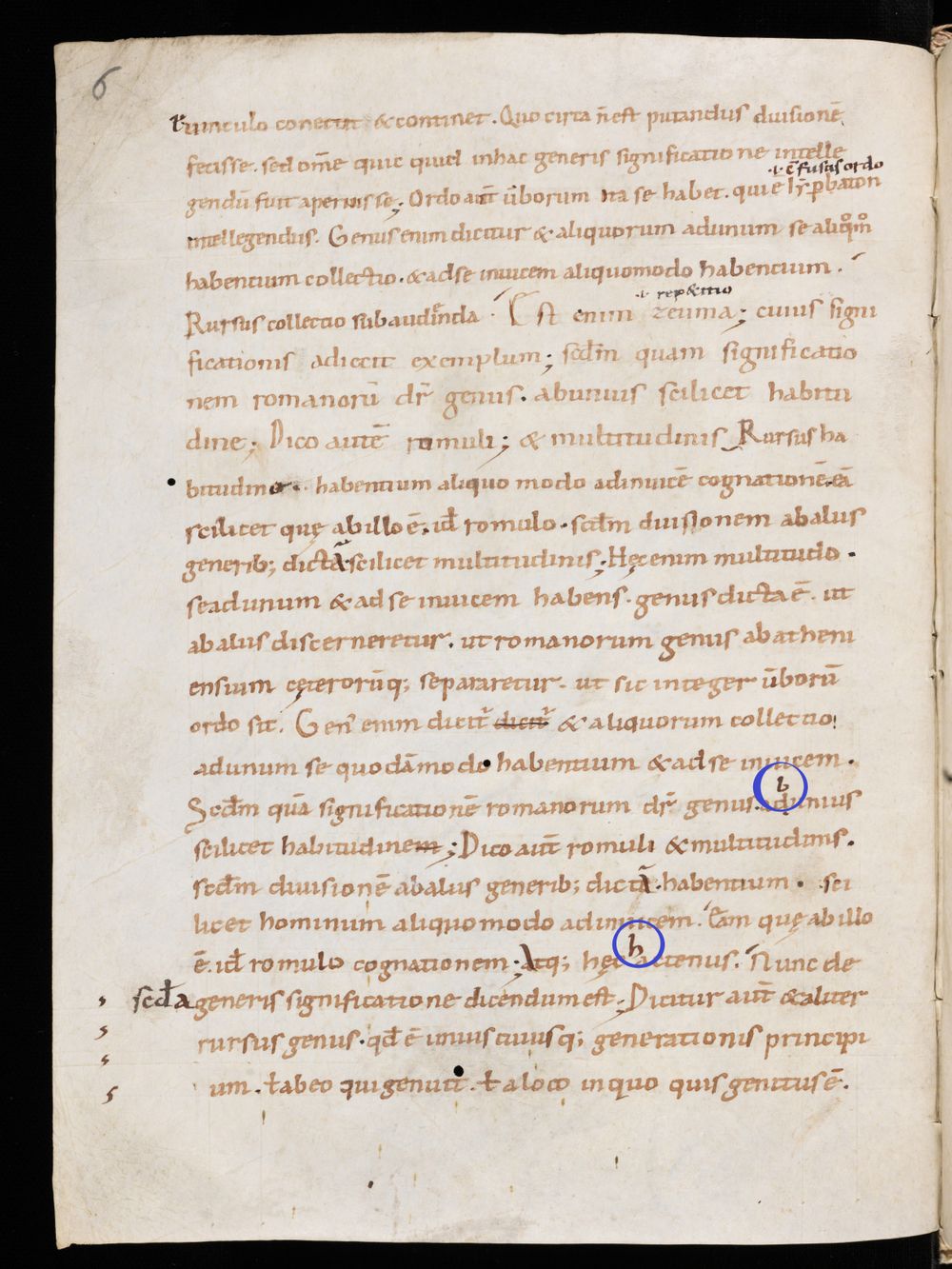

http://www.e-codices.ch/en/sbe/0315
Here small squiggles have been added in the margin alongside the text; these are rudimentary quotation marks indicating original text from the Isagoge, the subject of Boethius’s commentary.
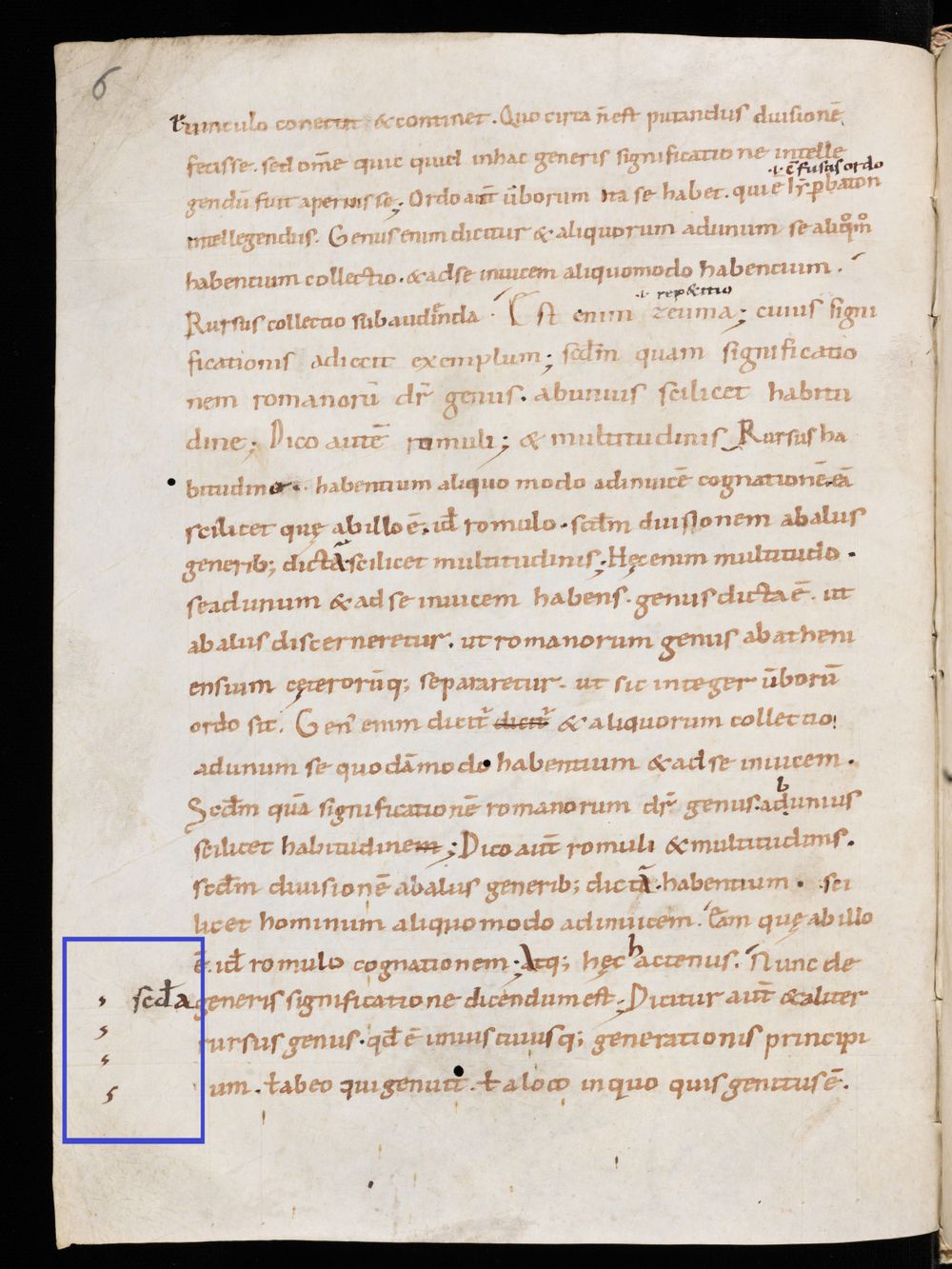

https://www.e-codices.unifr.ch/en/list/one/sbe/0315
Here interlinear glosses have been added to provide Latin equivalents of the Greek terms hyperbaton (transposition of words) and zeuma (where one word can be used in two different contexts). The glossator describes these as “confusus ordo”, the confusion of order, and “repetitio”, repetition, respectively.
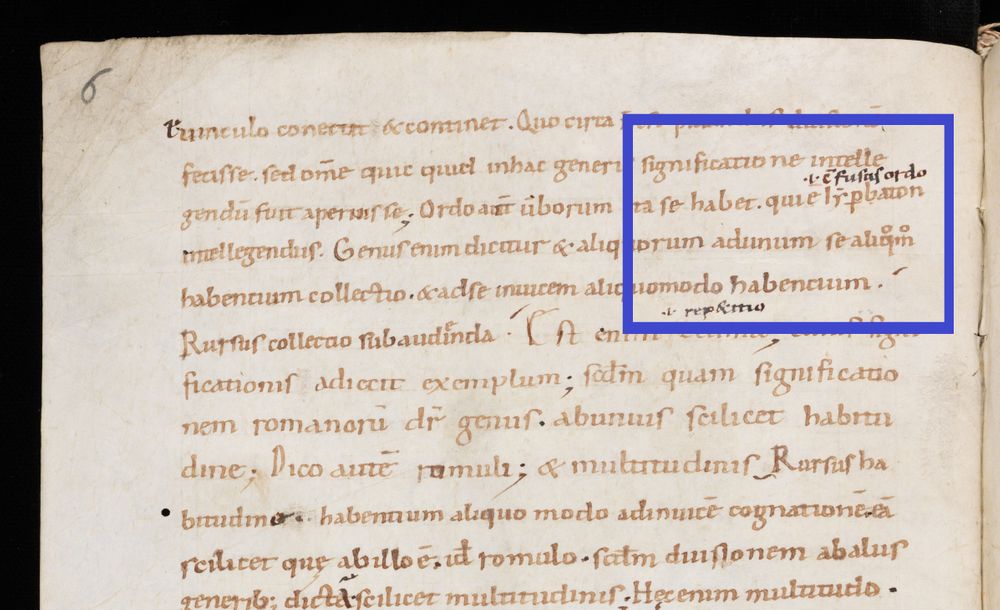
https://www.e-codices.unifr.ch/en/list/one/sbe/0315
While the preceding set of corrections and markups suggested that the text was prepared for attentive reading, the marginal activity here suggests otherwise. A half-finished doodle of a bearded face brings a (bored?) later reader to life. Meanwhile, we also find some traces of a scribe testing their quill, writing out the first letters of the alphabet (‘a, b, d, e, f, g’) as well as drawing a majuscule initial ’C’, perhaps in emulation of the style of the initial ‘S’ on this page.
_p164.jpg)
_p164.jpg)
Here a small slip of parchment has been added to the manuscript. Slips like this were sometimes used to supply extra or missing information. If we look at a detail of the other side of the scrap (p. 52a), we can see that the pores of the animal used to make the parchment are very visible. It is probable that this parchment was deemed unfit for inclusion in a manuscript, and so was cut up to be recycled in other ways, such as for this slip.
The slip has been used to provide a set of definitions from the famous encyclopedia, the Etymologiae, of Isidore of Seville. The section, taken from Etymologiae II.24.3, identifies three kinds, or ’species’, of philosophy: natural, moral, and rational. The rational type is, according to Isidore, called ‘loica’ (logic) by the Greeks. Isidore defines logic as occupied with the investigation of the truth, both in moral terms and in terms of disputations over the causes of things. This slip places the study of logic within a broader context of philosophy. Along with the study of physics (nature) and ethics (morality), the study of logic is a key component of philosophy.
_p52_b.jpg)
_p52_b.jpg)
The ‘Porphyrian tree’
The slip (p. 52) is found adjacent to this page, where Boethius discusses Porphyry’s definition of a species by genus and difference. It’s possible that the scribe was prompted to add the slip by Isidore’s reference to the ‘species’ of philosophy, that is, how the genus of philosophy could be further broken down into its constituent components. This ‘tree’ diagram accompanying this discussion, which is one of the earliest visualisations of Porphyry’s ideas in this form, concludes with the species ‘man’, ‘homo’. Here the classical philosophers Socrates, Cicero, and Plato, are listed as examples of the species ‘man’. Click here to find out more about the Porpyhyrian tree.
_p53.jpg)
_p53.jpg)
Visual representations of logic
This part of Boethius’s commentary (Book V, 12) deals with Porphyry’s discussion of the number of feasible ways in which the five predicables – genus, species, property, difference, accident – could be combined. Here each predicable is assigned a letter, a-e. As the illustration shows, a can be combined with b, c, d, and e; b can be combined with a, c, d, e etc. However, pairings repeat: it is possible to make four individual pairings between a and the other letters. But b can only be combined into three new individual pairings, c into two new individual pairings, and so on. Ultimately, therefore, 10 individual pairings can be made between the five predicables (4+3+2+1= 10). See another example of the abcde scheme in Paris, BnF lat. 12949.
_p139.jpg)
_p139.jpg)
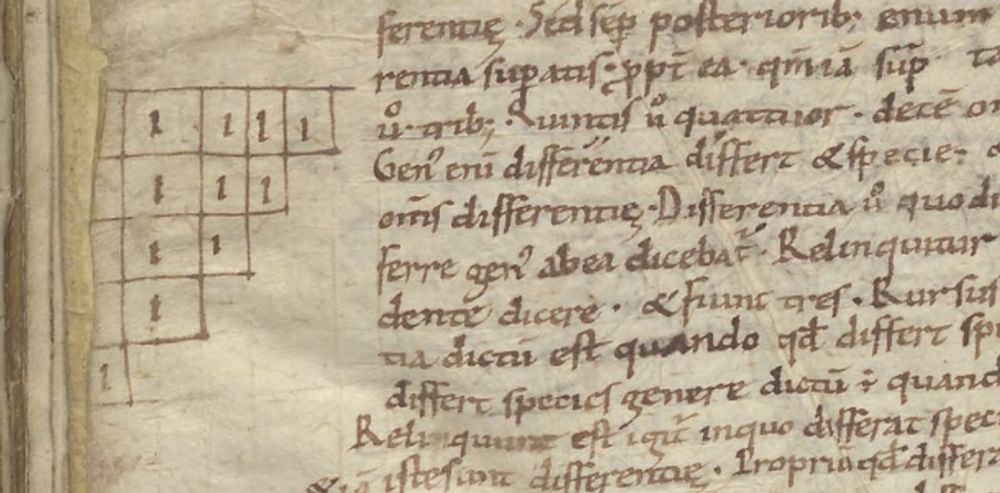

http://hdl.handle.net/1887.1/item:1687093
Decorating the text
Book V of Boethius’s commentary (Einsiedeln, SB, Cod. 315 (605), p. 114) opens with a decorated penwork initial in orange and red. The blank space at the top of this page was probably intended to accommodate a rubric introducing the textual division.
_p114.jpg)
_p114.jpg)
On p. 121 the lead outline of the initial ‘P’ used to guide the rubricator is clearly visible under the coloured ink. A small clue like this gives us a sense of the material processes used in making the manuscript.
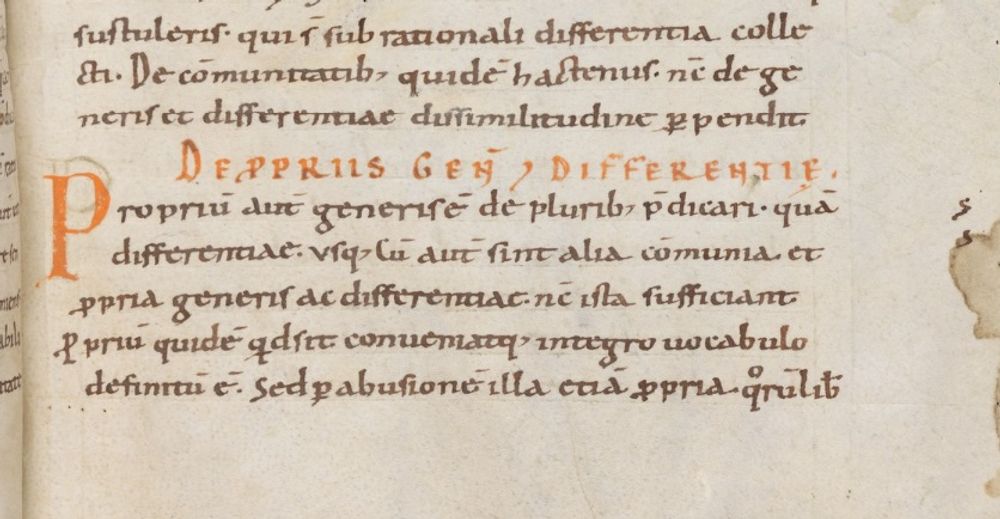

https://www.e-codices.unifr.ch/en/list/one/sbe/0315
Sources used for this contribution:
- Isidore of Seville, The Etymologies of Isidore of Seville, trans. S. A. Barney, W. J. Lewis, J. A. Beach, O. Berghof (Cambridge, Cambridge University Press, 2006)
- Marenbon, J., From the Circle of Alcuin to the School of Auxerre (Cambridge, Cambridge University Press, 1986)
- Meier, G., Heinrich von Ligerz: Bibliothekar von Einsiedeln im 14. Jahrhundert (Leipzig, Otto Harrassowitz, 1896)
- Migne, J.-P. (ed.), Patrologia Latina, vol. 64
- Smith, L. (ed.), Codices Boethiani, A conspectus of the works of Boethius, vol. II (London, University of London Press, 2001)
- Verboon, A., ‘The Medieval Tree of Porphyry: An Organic Structure of Logic’, in A. Worm and P. Salonius (eds), The Tree. Symbol, Allegory and Structural Device in Medieval Art and Thought (Turnhout, Brepols, 2014), 83-101
Contribution by Irene O’Daly.
Cite as, Irene O’Daly, “Einsiedeln, Stiftsbibliothek, Codex 315 (605)”, The art of reasoning in medieval manuscripts (Dec 2020), https://art-of-reasoning.huygens.knaw.nl/cod315. ↑


